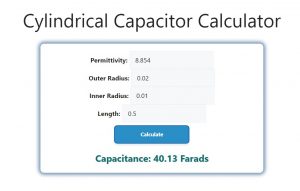About Cylindrical Capacitor Calculator (Formula)
Cylindrical capacitors are essential components in various electrical and electronic applications, providing energy storage and voltage stabilization. Understanding how to calculate the capacitance of a cylindrical capacitor can help engineers and hobbyists design circuits effectively. This article will introduce the formula for calculating capacitance, how to use the calculator, and address common questions related to cylindrical capacitors.
Formula
The formula for calculating the capacitance (C) of a cylindrical capacitor is:
C = (2 * π * ε) / ln(b/a) * L
In this formula:
- C represents the capacitance in farads (F).
- ε is the permittivity of the material between the capacitor’s plates.
- ln(b/a) is the natural logarithm of the ratio of the outer radius (b) to the inner radius (a).
- L represents the length of the capacitor.
How to Use
Using the Cylindrical Capacitor Calculator is straightforward and involves the following steps:
- Identify Parameters: Gather the necessary parameters, including the inner radius (a), outer radius (b), length (L), and the permittivity (ε) of the dielectric material.
- Input Values: Enter the values for the inner radius, outer radius, length, and permittivity into the calculator.
- Calculate Capacitance: Press the calculate button to determine the capacitance of the cylindrical capacitor.
- Review Results: Analyze the calculated capacitance and make any necessary adjustments to your design.
Example
Let’s consider an example to illustrate the use of the Cylindrical Capacitor Calculator:
- Inner Radius (a): 0.01 m
- Outer Radius (b): 0.02 m
- Length (L): 0.5 m
- Permittivity (ε): 8.854 x 10^-12 F/m (for vacuum)
- Use the Formula: C = (2 * π * 8.854 x 10^-12) / ln(0.02/0.01) * 0.5
- Calculate: C ≈ (5.579 x 10^-11) / (0.693) * 0.5
C ≈ 4.03 x 10^-11 F
In this example, the capacitance of the cylindrical capacitor is approximately 40.3 pF (picoFarads).

FAQs
- What is a cylindrical capacitor?
A cylindrical capacitor consists of two concentric cylinders separated by a dielectric material, storing electrical energy in an electric field. - What is capacitance?
Capacitance is the ability of a capacitor to store electric charge, measured in farads (F). - How does the dielectric material affect capacitance?
The dielectric material’s permittivity directly influences the capacitance; materials with higher permittivity provide higher capacitance. - What does the formula for capacitance mean?
The formula considers the geometry of the capacitor and the properties of the dielectric, determining how much charge can be stored. - Can I use the calculator for non-cylindrical capacitors?
No, this calculator is specifically designed for cylindrical capacitors; other shapes require different formulas. - What is the significance of the natural logarithm in the formula?
The natural logarithm accounts for the ratio of the outer and inner radii, reflecting how the capacitor’s geometry affects capacitance. - What units are used for each parameter?
The inner and outer radii, as well as the length, should be in meters, while permittivity is in farads per meter. - Is it possible to calculate the capacitance without the calculator?
Yes, using the formula provided, you can manually calculate the capacitance if you have all the necessary parameters. - What happens if the inner and outer radii are too close?
If the inner and outer radii are too close, the capacitance will be very small, potentially leading to high electric fields and breakdown of the dielectric. - What is the role of length in determining capacitance?
Increasing the length of the capacitor increases the capacitance, allowing for more stored charge. - How do I choose the right dielectric material?
The choice of dielectric material depends on the application’s voltage requirements, thermal stability, and desired capacitance. - What is the typical use of cylindrical capacitors?
They are commonly used in filters, oscillators, and tuning circuits in electronic devices. - Can cylindrical capacitors be used in high-voltage applications?
Yes, but the dielectric material must be chosen to withstand the high voltage without breaking down. - What are the limitations of cylindrical capacitors?
They can be larger and heavier than other capacitor types, which may limit their use in compact designs. - How does temperature affect capacitance?
Temperature variations can alter the permittivity of the dielectric material, thus affecting capacitance. - What is the effect of frequency on cylindrical capacitors?
At high frequencies, capacitors may exhibit reduced capacitance due to parasitic effects and dielectric losses. - Can I stack cylindrical capacitors?
Yes, capacitors can be stacked in series or parallel configurations to achieve desired capacitance values. - How do I determine the breakdown voltage of my capacitor?
The breakdown voltage is determined by the dielectric material properties and thickness, typically found in the material specifications. - Are there cylindrical capacitors available commercially?
Yes, cylindrical capacitors are widely available in various capacitance values and voltage ratings. - What precautions should I take when using cylindrical capacitors?
Ensure proper handling to avoid damage, respect voltage ratings, and ensure adequate spacing between components to prevent shorts.
Conclusion
The Cylindrical Capacitor Calculator is a valuable tool for anyone involved in electronics and circuit design. By understanding the formula and how to use the calculator, you can efficiently determine the capacitance of cylindrical capacitors, leading to better design decisions. Whether for educational purposes, engineering projects, or hobbyist experiments, mastering the capacitance calculation can enhance your overall comprehension of electrical components and their applications.